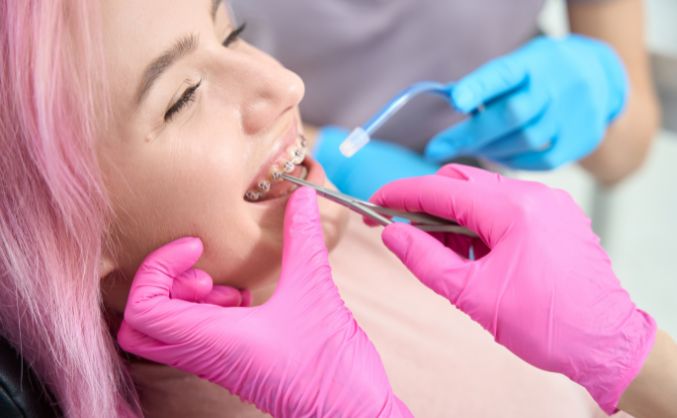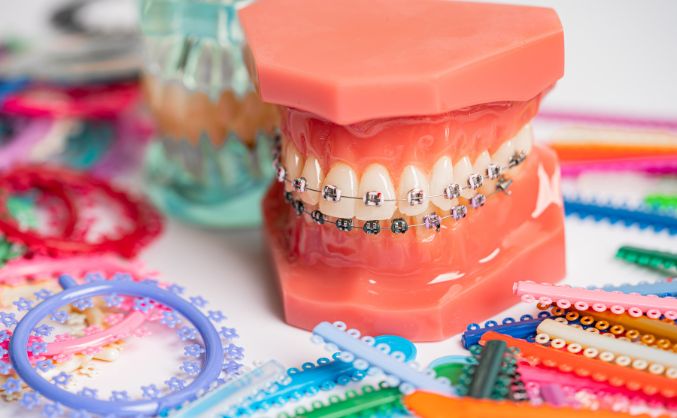Are you curious about what rubber bands do for braces? Well, rubber bands, also called elastics or orthodontic elastics play an important role in your treatment. They actively work to straighten your teeth and improve your bite. Let’s explore their significance in your orthodontic journey towards a dazzling grin.
Braces: The Brawn Behind the Smile
Braces are the workhorses of orthodontic treatment. The brackets bonded to your teeth and the wires connecting them apply gentle, constant pressure. This pressure is what allows for gradual tooth movement and realignment over time.
But braces have their limitations. While they can achieve a lot, there are certain situations where they might need a little extra help. This is where those rubber bands come in!
Rubber Bands: The Targeted Force for Precise Movements
Think of rubber bands as the precision tools in your orthodontist’s arsenal. They provide additional, targeted forces that braces alone can’t exert. Your orthodontist hooks the elastics onto different brackets on your braces in various configurations. They’ll move them around depending on your specific needs.
Here are some of the ways rubber bands can help with your treatment:
- Correcting Bite Issues: Rubber bands help correct bite issues like overbites, underbites, open bites, and crossbites. By applying pressure in specific directions, they guide the jaw and teeth into their ideal positions. For example, if you have an overbite, rubber bands can push your upper teeth back and your lower jaw forward.
- Closing Gaps: If you have gaps between your teeth, elastics gently pull the teeth together.
- Rotating Teeth: Rubber bands can also rotate individual teeth like your top canines, that are slightly tilted.
The Dynamic Duo: Braces and Rubber Bands Working Together
Braces and rubber bands work together to achieve optimal results in your orthodontic treatment. Braces provide constant, gentle pressure for overall tooth movement, while rubber bands add targeted forces for more precise adjustments. This teamwork can help:
- Reduce Treatment Time: By applying additional pressure, rubber bands can sometimes help move your teeth more quickly. The bonus: potentially shortened overall orthodontic treatment time.
- Improve Treatment Outcomes: Elastics apply focused pressure to fix bite problems that braces alone might miss. Think of specific bite issues and misalignments. The result is a more precise and stable smile in the end.
For more information on braces and rubber bands, check out this article from Colgate.

Get Your Smile on Track with Expert Orthodontic Care from Murray Orthodontics
As you can see, rubber bands are an important part of your orthodontic treatment. Be sure to follow your orthodontist’s instructions closely when wearing them. They’ll provide guidance on how to wear the elastics and when you should change them. It’s essential to consistently and correctly use rubber bands (wearing your elastics as instructed) to maximize your treatment plan.
Ready to take the first step towards a straighter, healthier smile? Visit Murray Orthodontics to learn more about our services and schedule a consultation today! Our experienced team personalizes orthodontic care tailored to your unique needs. Whether you’re dealing with bite issues, gaps between teeth, or misalignments, we’ll help you achieve the smile you’ve always wanted.
From wearing rubber bands to adjusting braces, we’ll guide you every step of the way. Don’t wait any longer — let’s start your orthodontic journey together today!
Frequently Asked Questions
Q: Will rubber bands make my braces feel uncomfortable?
A: Initially, wearing rubber bands may cause some discomfort or tightness as your teeth adjust to the added pressure. However, this discomfort typically diminishes over time as you become accustomed to wearing them.
Q: How often do I need to wear my elastics?
A: You should wear your elastics as directed by your orthodontist. Typically, you’ll wear them around the clock unless instructed otherwise. Consistency in wearing your elastics is essential for achieving optimal results.
Q: What happens if I lose an elastic band?
A: If you lose an elastic band, contact your orthodontist as soon as possible. They will guide you as to whether you should replace the band immediately or wait until your next appointment.
Q: Can I eat with my rubber bands in?
A: We recommend removing your rubber bands before eating. Remember to store them safely during meals and reapply them afterward as directed by your orthodontist.
Q: How should I take care of my extra elastics?
A: It’s essential to store your extra elastics in a clean, dry place away from direct sunlight or heat. Avoid stretching or twisting them unnecessarily, as this can affect their elasticity. If you have any concerns about your elastics, don’t hesitate to consult your orthodontist for guidance.

